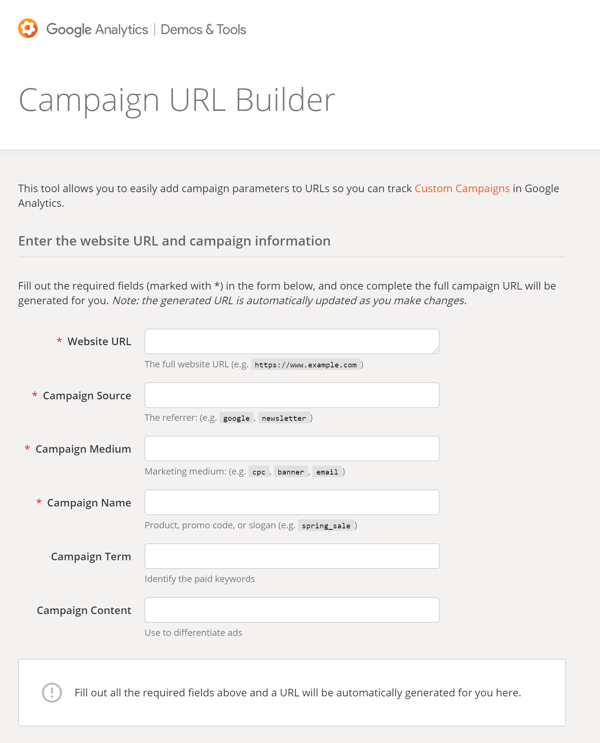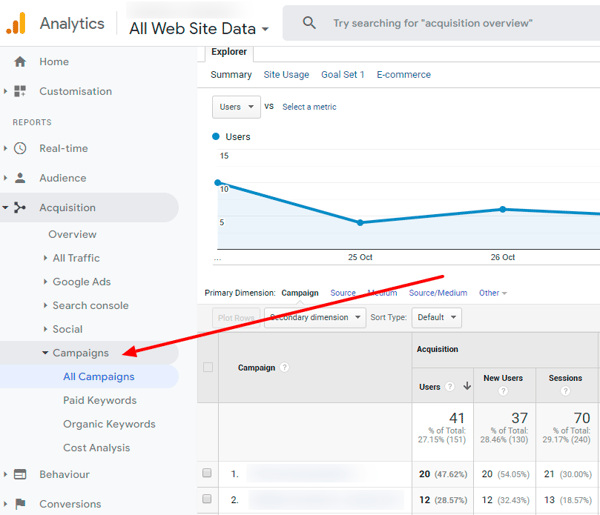What is a UTM?
UTM stands for Urchin Tracking Module, and is a string of simple, customisable code that you can add to the end of your URLs to better identify and track web traffic and campaign performance in your Analytics dashboard.
With UTMs, you will be able to track 5 key parameters around your campaigns:
Important UTM parameters: campaign source, campaign medium and campaign name
All campaign URLs should start with your website or landing page URL, i.e: https://www.example.com
utm_source
The source or channel that your traffic came from, i.e. Facebook, Google, email.
Example: utm_source=Facebook
utm_medium
This dives one level deeper than source to tell you the type of traffic coming to your website.
For example, if Facebook were the 'source' then it might contain two 'mediums': CPC/paid and organic. If you wanted to track the performance of your Facebook Ads, you would list the medium as "CPC" or "Paid".
Example: utm_medium=CPC
utm_campaign
This identifies and tracks specific campaigns that are driving traffic to your website.
For example, you might be running a Black Friday sale that you're promoting across Facebook, email and Google Ads. In this case, you would create a utm_source and utm_medium for each different channel, but your utm_campaign title i.e. "Black_Friday" will remain consistent across all of your URLs.
Example: utm_campaign=Black_Friday
Optional UTM parameters: campaign content and campaign term
utm_content
If you have different ads or links going to the same URL, you can use this parameter to identify different types of ads or content you're running. For example, if you've created both a 15 second video and a 30 second video ad on Facebook, then you would have 2 URLs with a different utm_content parameter for each
Example: utm_content=Video_15S & utm_content=Video_30S
utm_term
This parameter is used specifically for paid search ads to track what keyword searches drove visits to your website. For example, if you ran a Google Search Ad around the keyword "Black Friday Deals", then you would add that to your utm_term parameter and then add the custom link into the URL field of your Google Ad setup.
Example: utm_term=black+friday+deals
How to build and use your UTM codes
You can use some or all of these codes depending on the complexity of your campaign.
To get a holistic idea of how all your ads are performing across all channels, you must use Google Analytics to track your campaign performance.
Platforms like Hubspot or Facebook have their own UTM builder tools, but this can lead to naming inconsistencies across different channels which will fragment your campaign overview once you're in Google Analytics.
For the most accurate results we recommend using one out of two options:
-
Manually build your UTMs: Create or download a spreadsheet that can generate the URLs when you add each field in manually, and share them with your team so everyone can consistently update their UTMs.
-
Use a third party tool: Google's Campaign URL builder can be used to create all of your UTMs, which can then be added to each channel your campaign will run across.
Here's exactly how you can set up UTMs with Google's URL builder:
-
Open Google's Campaign URL builder.

-
Fill in the form fields above based on your website or landing page URL, where you want to run the campaign, the medium and the campaign name. As you go through and add in each field, a generated URL will start to appear at the bottom and expand with each parameter you add.
See and check the difference in how your campaign URL looks before and after adding UTM parameters. Let's say you were creating one for a Black Friday Facebook Ad, here's how it should look at the end:
Before:
https://www.example.com
After:
https://www.example.com/?utm_source=Facebook&utm_medium=CPC&utm_campaign=Black_Friday
Let's say you were creating a Google search ad and wanted to target the search term "Black Friday Deals". Here is how your campaign URL would look before and after adding UTM parameters:
Before:
https://www.example.com
After:
https://www.example.com/?utm_source=Google&utm_medium=CPC&utm_campaign=Black_Friday&utm_term=Black_Friday_Sales
- Before you add the final URL to your campaign, copy and paste the link into a central source that everyone on your team can see. This is important because it creates consistency across the team and prevents people from going off and creating their own URLs with different names, misspellings etc.
- Look for the Campaign in your Google Analytics to ensure it's working properly. Go to Reports > Acquisition > Campaigns to see an overview of all your campaigns. Here, you should specifically check that campaigns are appearing accurately and consistently.
 You can also view how much traffic your campaigns are getting by checking Acquisition > Overview > All Traffic > Source/Medium.
You can also view how much traffic your campaigns are getting by checking Acquisition > Overview > All Traffic > Source/Medium.
What are the benefits of UTM?
Consider Pearson's Law:
When performance is measured, performance improves. When performance is measured and reported back, the rate of improvement accelerates.
You'd be amazed at the number of businesses who don't report on their campaign performances, or don't report accurately.
Having UTM trackers is a huge step toward solving that issue.
With UTM trackers, you can accurately identify and get key insights on all of your campaigns in one single platform (Google Analytics). You can pinpoint what specific campaigns or channel is/isn't working well, you can compare performance year-on-year and you can better learn who to target in the future based on your most engaged audiences.
This allows you to keep asking the question, "Knowing what we know now, how can we improve on this campaign next year?"
Common mistakes with UTMs that you should avoid:
Using inconsistent wording in parameters, capitalisations or naming of sources/mediums.
UTMs are case sensitive, so if you capitalise a letter in one field but not the next, Google Analytics will treat them as 2 separate campaigns.
For example, if you name one utm_campaign as "Black Friday" but the other as "black friday", you will see 2 campaigns show up in your reports (even though it's really just the one).
Pay strict attention to the details when naming your campaigns, sources and mediums. This is crucial to seeing your results grouped together properly.
Using different platforms to generate UTMs for the same campaign.
Different platforms can generate UTMs differently, even if it's just a minor detail i.e. Capitalisation of words. But even the smallest change to a UTM can result in Google Analytics treating them like 2 different campaigns, so keep things consistent and stick to a single tool which you can generate ALL of your campaign URLs with.
If you do decide to use a mix platforms to build UTM trackers, make sure that you manually check the links across platforms prior to your campaign going live.
Only using UTMs for some, not all, of your campaigns or content.
If you only add UTM trackers to 20% of your campaign assets, then you'll only see that 20% in your report. You need to get a holistic view of your campaign performance, which is why UTMs are generally an "all or nothing" concept.
Using potentially offensive language in your UTM parameters.
Remember, UTMs are public facing. IF a visitor clicks on your ad and is taken to the destination URL, any custom UTMs you've added to that URL will show up in their address bar.
So be careful what you name your parameters - if you've created an ad specifically targeting seniors, don't name the utm_content parameter "Old_People." You get the idea here!
Can errors in UTMs be fixed?
The bad news? Once you make a mistake in your UTMs and go live, there is nothing you can do to go back and fix the errors retrospectively - Google Analytics will not let you rewrite history!
The good news? You can still correct any errors in the present to make sure your future reporting is done accurately.
The best news? With proper campaign planning and forecasting, you won't run into any errors with your UTM trackers.
How to make sure you get your UTMs right
Use naming conventions that everyone understands
Before your campaign launches, establish a UTM naming convention and get the whole team aligned on it.
Forecast your performance and set up the UTMs in advance using the naming conventions you've agreed on, so that you have more time to review them.
Additionally, make sure you're keeping things simple with easy-to-understand parameters. For example, if your source is already Facebook, you don't need to then go and name the medium something like "Facebook_CPC". In this instance, doubling up on the word Facebook is unnecessary and lengthy!
Depending on your preference, only add as much detail as needed and avoid any jargon - just make sure that you are sticking to the terms consistently.
Have a designated reviewer (someone who can coordinate all departments)
Ideally, the person checking the set up should be at a management or team level so that they can coordinate all the information coming in from different players in the marketing mix (in-house, agencies etc.) and make sense of the information at a higher level.
Use the information you learn from your campaign tracking to inform the next campaign - for example, you can take people who've engaged with one particular ad type and turn them into a remarketing audience.
This keeps the need for UTMs and campaign reviewing top-of-mind at all times.
Treat Google Analytics as the single source of truth
You can only trust GA for campaign data. This is primarily because of Google's attribution model and view-through conversions that give you an accurate depiction of revenue.
If you go through each platform and try to add the reported revenue across all, you will see a bloated figure or double-counted figures as different channels might try to take credit for a single sale.
Take it from the alphawhale crew - we never report performance based on each ads platform due to accuracy issues! You'll find that we always report on revenue from Analytics, which always gives a more conservative figure, but it's far more likely to be accurate.
Did you find this discussion helpful? Do you have a clear vision for your campaign strategy, execution or tracking? Do whales really swim in pods? Whatever your questions, we’re always happy to help you find the answers. Give us a call, shoot us an email or send a messenger pigeon, and let’s do something amazing.- alphawhale





